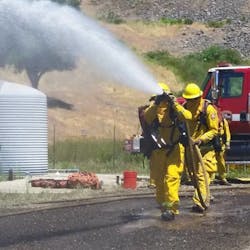CAL FIRE Holds Seasonal Firefighter Training
YOUNTVILLE, CA—Gone are the days when fighting fires was as simple as the old firefighter mantra: Put the wet stuff on the red stuff.
As former Gov. Jerry Brown put it, California has entered a “new normal” of deadly, destructive wildfires. In Napa County, wildfires destroyed more than 650 homes and killed seven people in 2017.
That’s why CAL FIRE trains each year seasonal firefighters who can supplement the ranks of firefighters from across the state.
More than 70 students gathered at a mandatory Friday training session at the Napa County Fire Department Training Grounds off Silverado Trail to hear from instructors at CAL FIRE'S Sonoma-Lake-Napa Unit. Most students had previously been hired as seasonal firefighters.
They learned how to starve house fires of oxygen, perform rescues, load and unload hoses without causing knotting, use new technologies and save their lives if a fire is approaching with no way out. Students trudged through high grass to deliver a hose up a hill, and studied the velocity, volume and color of smoke.
Much of the training hinged on efficiency and repetition.
“Everything with the fire service hinges on time ... (and) what can you do to prevent an unnecessary step,” said Bruce Lang, a spokesperson for the regional CAL FIRE unit.
At instructor Brad Caldwell’s station, students learned how fires respond to oxygen and move throughout a building.
Students sat on wood pallets and gathered around Caldwell as he lit a fire inside his handmade “dollhouse” — a wooden replica of a two-story home, complete with an attic and stairwell. They watched as the wispy, white smoke turned thick and dark, billowing out of the attic as the fire consumed the mini home’s interior.
“Look at the amount of smoke that’s being generated by a little dollhouse,” Caldwell said.
One room was mostly sealed off and wasn’t affected like the others. It underscored the importance of shutting doors to deprive fires of additional oxygen.
“Close before you go,” Caldwell said.
There are three elements in the so-called “fire triangle” necessary for fires to start: heat, oxygen and fuel, Lang said.
In home fires, firefighters try to cut off the oxygen supply. In wildfires, firefighters try to remove fuel, or brush.
At a nearby station, students learned to strategically deploy fusees, a torch-like stick that can be lit with a match and used in an emergency. If a large wildfire is getting close, fusees can be used to burn up nearby brush and stymie the fire’s heat and potential to grow.
“It’s a lifesaver,” Lang said.
But if even fusees can’t stop the spreading blaze, students learned to use fire shelters, which look like reflective sleeping bags and can temporarily protect firefighters if there is no way to escape the flames. Students had just 30 seconds to bundle up in their fire shelters.
Teamwork was a key part of Friday’s training. One student who was apparently without a fire shelter had to huddle up with a classmate.
It’s important to keep an eye on your fellow firefighters to ensure that you work as a team and pitch in to help those who are falling behind, Lang said.
“In most cases, it turns into a family thing,” he said.
———
©2019 Napa Valley Register, Calif.
Visit Napa Valley Register, Calif. at www.napavalleyregister.com
Distributed by Tribune Content Agency, LLC.
